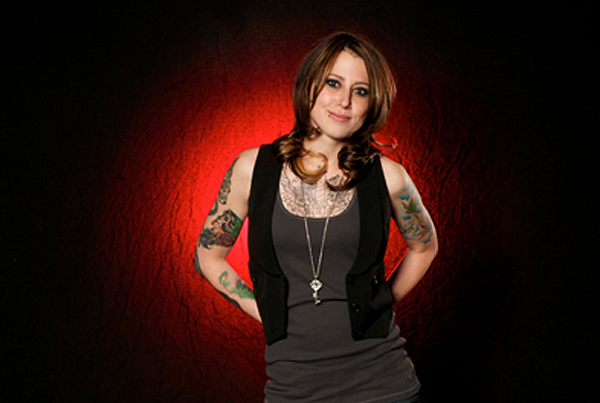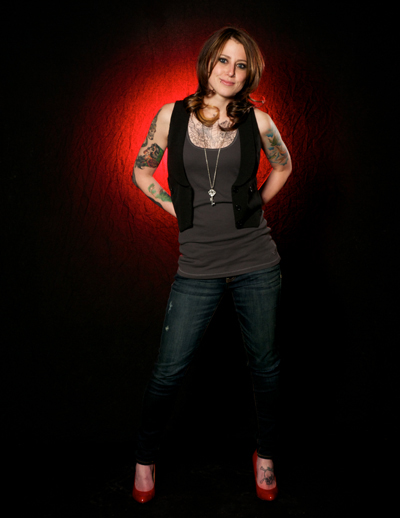Life on their own terms: tattoos and gay culture


Older people are coming out these days – out as pro-tattoo.
“I had a sixty-eight year old woman come in the other day,” said Inferno tattoo artist Erin Rust. “It was her birthday, and she said, ‘I want to get some lip marks on my ass. Because everyone can just kiss my ass.'”
It’s no secret the popularity of tattoos has been on the rise for some time, and now that everything from a sleeved arm to a tribal tramp-stamp are as common as a pair of earrings, some of the elderly are making up for lost time.
“It’s not like they’re going through a midlife crisis,” said Rust. “They come in saying ‘I really wanted this when I was 20, but it wasn’t acceptable then.’ There was a sixty-three-year-old woman who came in wanting all the Johnny Depp characters on her back: The Mad Hatter, Captain Jack Sparrow, etc. It’s just so much more acceptable now.”
Rust, 25, represents a generation that grew up with tattoos as an everyday encounter. This first presented itself to a fresh-faced Rust several years ago, when she moved to Denver as a student at Rocky Mountain College of Art and Design.
“People were expressing themselves differently there. I saw a lot of tattoos, stretched ears, piercings, weird hair colors. College is that time when people can really begin to express themselves. It feels great to be somewhere where you can be yourself.”
Rust had been having a little trouble with that. After spending four and a half years in a heterosexual relationship, the time had come to admit to herself – and everyone else – that she was, in fact, gay.
“My family was very supportive,” Rust said. “I just told them ‘I’m going out on a date tonight.’ They asked ‘who’s the lucky guy?’ and I said ‘her name is Leslie.'”
After that relationship eventually ended (along with a job in what Rust distastefully refers to as “corporate America”) Rust had finally carved out a space where she could be herself. “I had just come out and had my first girlfriend, and I was passionate about that.”
Like most first-timers, the young Rust wanted her first tattoo to be special. Now the word “Passion” can be found down the side of her torso, decorated with stars and flowers in honor of the time in her life when she decided to live how she wanted.
Thankfully, Rust didn’t have to wait until she was sixty-eight to make that decision.

There was a time when being tattooed was synonymous with being filthy or unrespectable. Erin Rust’s decision to have calligraphy permanently inked down the side of her body (followed by many other tattoos) is indebted to the generations that embraced the excitement of tattooing long before it was acceptable.
When a grinning Tim Curry asks his frightened captors if they “have any tattoos?” in The Rocky Horror Picture Show, what he’s really asking is “have you ever done anything naughty?” At the time the film came out, sporting a tattoo could hinder a professional career, labeling the bearer an outcast, inspiring disgust from conservative mothers. Tattoos were something to be regretted, and if you did have one you were smart to keep it hidden.
Sound familiar?
In Mike Mill’s new true-story film Beginners is the all-too-familiar story of a man discovering late in life that his psychologist was wrong: it is OK to be gay. After being convinced in 1940 that homosexuality is a mental illness, Hal lives a life of awkward heterosexuality until the death of his wife. Hal has reached his eighties by this time, but he’s determined to enjoy the freedoms won by the baby-boomer generation.
The history of tattoos in America is an almost-exact parallel to the gaining respectability of alternative sexuality.
Following World War II, some of the only citizens proudly displaying a tat on their forearms were sailors. Not to mention, as we have been informed by The Village People, the Navy was also a place where you could, wink-wink, “meet your fellow man.” Religious conservatives would inevitably point them toward the Book of Leviticus and it’s condemnation of tattoos – the same part of the Bible most often cited against same-sex relationships.
Attitudes towards tattoos and piercings shifted in the 90s. Children of the hippie generation had reached maturity and saw nothing wrong with a butterfly on the ankle or barbed wire wrapping a bicep. It was simultaneous with leaps forward for the gay rights movement with changing perceptions towards AIDS and same-sex marriage.
In 2008, National Geographic estimated that around 15 percent of Americans had one or more tattoos, – more than twice Life Magazine’s 1940 estimate that just 6 percent of the country had gone under the needle.
Then again, just as statistics on sexuality in America are uncertain, the data about tattoos is suspect.
“While tattooing is one of the fastest-growing industries in the country,” said Lou Bardach, a gay tattoo enthusiast and co-founder of tattoofinder.com which connects clients with a database of thousands of tattoo-ready images, “so much of it is under the table that it can be really difficult to get accurate statistics.”
 Having been around the tattoo industry since the early ’90s with his sister, fellow tattoo-artist and tattoofinder co-founder Rachael Bardach, Lou Bardach has seen how tattoos have progressed alongside LGBT rights.
Having been around the tattoo industry since the early ’90s with his sister, fellow tattoo-artist and tattoofinder co-founder Rachael Bardach, Lou Bardach has seen how tattoos have progressed alongside LGBT rights.
“When someone finds a good dentist, they tend to stick with him,” Bardach explained, “and it’s the same with a good tattoo artist. Especially for gays and lesbians. You’re going to be stuck next to this person for hours, so if they start on a homophobic rant, it can get quite uncomfortable.”
Bardach said that LGBT people often ask him to recommend a tattoo shop. Beyond the interest in finding a competent artist, LGBT customers want someone gay-friendly.
Where the LGBT movement and tatto culture differs is in lingering homophobia in some of the older, macho tattoo shops – cultures that reflexively promote violence and misogyny. Such a prospect could dissuade someone who’s already apprehensive about having his or her skin drilled with needles and ink.
Yet there’s no shortage of people like Lou Bardach, who is proud to live how he wants despite the old guard.
“The type of groups that allow people to feel comfortable coming out as gay are typically the same that allow people to feel comfortable coming out as tattooed,” Bardach explained.

Despite his feeling that we’re still a few years off from getting completely accurate statistics on tattoos, Bardach has compiled on his site what available data exists. At one point Bardach notes a Harris Interactive study finding 31 percent of gays and lesbians have tattoos – twice the national average – while 36 percent of those are between the ages of 25-29.
Last September pop sensation Miley Cyrus caught flack from anti-gay/anti-tattoo conservatives when she tweeted a picture of her new tattoo: a gay-rights “equal” sign on her ring finger.
Like the rights won by generations before us at Stonewall and political battles of the ’90s – movements hoping to make the world a safe place for gays and lesbians – there has been a cultural-shift in attitudes toward tattoos. Someone like Erin Rust can not only hold hands with her girlfriend in public, but she can proudly display tattoos on those hands, helping an older generation take notice and begin living life the way they want to as well.
What's Your Reaction?
Josiah Hesse writes music, feature interviews and news coverage for Out Front Colorado.









